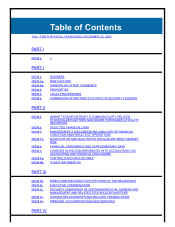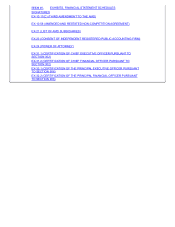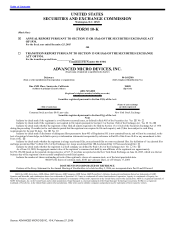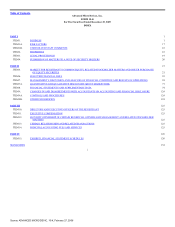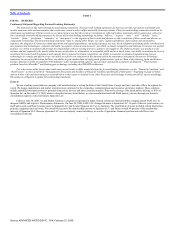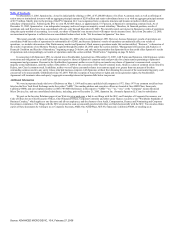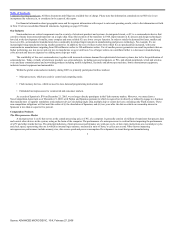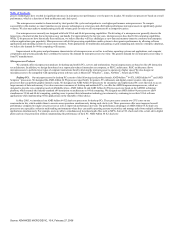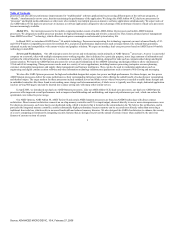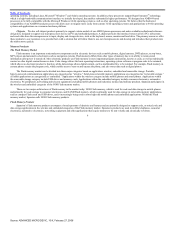AMD 2005 Annual Report Download - page 12
Download and view the complete annual report
Please find page 12 of the 2005 AMD annual report below. You can navigate through the pages in the report by either clicking on the pages listed below, or by using the keyword search tool below to find specific information within the annual report.
Table of Contents
Spansion Flash memory products are based on two technologies today: single bit-per-cell floating gate technology and two bits-per-cell MirrorBit
technology. Flash memory technology refers to the structure of an individual memory cell or transistor.
Floating Gate Technology. Floating gate is the conventional memory cell technology that is utilized by most Flash memory companies today for both
NOR and NAND products. A memory cell comprises a transistor having a source, a drain and a control gate to regulate the current flow between the source and
the drain, thereby defining whether the memory cell stores a “0” bit or a “1” bit by storing a charge in the cell storage medium. Floating gate is a memory cell
technology in which the “floating gate” is a conductive storage medium between the control gate and the source and drain. It is referred to as a floating gate
because it is electrically isolated or “floating” from the rest of the cell to ensure that stored charge does not leak away resulting in memory loss. Spansion’s
products using floating gate are typically used for code storage for applications requiring very high read speeds, extreme temperatures and harsh environments
such as automotive applications.
Floating gate technology has traditionally stored one bit of data per memory cell, referred to as single level cell floating gate technology, or SLC. To
achieve higher densities and lower costs per bit, the industry has developed floating gate technology to store two bits of data per memory cell, referred to as
floating gate multi-level cell, or MLC, technology. MLC floating gate stores one of four different quantities of charge, known as fractional charge storage, in the
memory cell; these different quantities of charge are decoded as equivalent to two bits of information. Spansion has chosen not to use MLC floating gate to
achieve two bits per cell in its products.
MirrorBit Technology. Spansion’s Flash memory products also include devices based on MirrorBit technology, which is a proprietary technology that
stores two bits of data in a single memory cell thereby doubling the density, or storage capacity, of each memory cell and enabling higher density products.
However, unlike the conductive storage medium used by floating gate technology, MirrorBit technology stores charge in a non-conductive storage medium,
silicon nitride, without the need for a floating gate. While electrons stored on a floating gate will diffuse, those stored in a particular location of a MirrorBit
nitride cell will stay in place. This enables MirrorBit to store charge in two physically distinct locations, rather than having to use four levels of charge like MLC
floating gate Flash memory. Storing charge in a silicon nitride layer and eliminating the requirement for a floating gate simplifies the manufacturing process,
which results in higher yields. MirrorBit technology offers manufacturing cost advantages compared to MLC floating gate NOR technology.
Spansion’s product portfolio ranges from one megabit to 512 megabits. While historically Spansion’s products have been based on floating gate
technology, the majority of its new product designs use MirrorBit technology. Spansion’s products have traditionally been designed to support code, or mixed
code and data storage applications and serve the wireless and embedded categories of the Flash memory market. Some of its product families address both of
these categories.
Personal Connectivity Solutions
The Embedded Processor Market
We also offer embedded microprocessors for personal connectivity devices and specific consumer markets. Personal connectivity devices can be classified
into four main segments: computer devices such as thin clients, smart handheld devices and PDAs; access devices such as gateways and access points;
entertainment devices such as media players and digital TVs; and automotive devices such as in-car navigation systems, telematics and media playback. The
applications in these devices typically require highly integrated systems-on-chip, or SoCs, that include high-performance, low-power embedded processors and
microcontrollers.
Personal Connectivity Solutions
We offer low-power, high-performance embedded microprocessor products for personal connectivity devices. Our products include low-power x86 and
MIPS® architecture-based embedded processors. We design these
7
Source: ADVANCED MICRO DEVIC, 10-K, February 27, 2006


